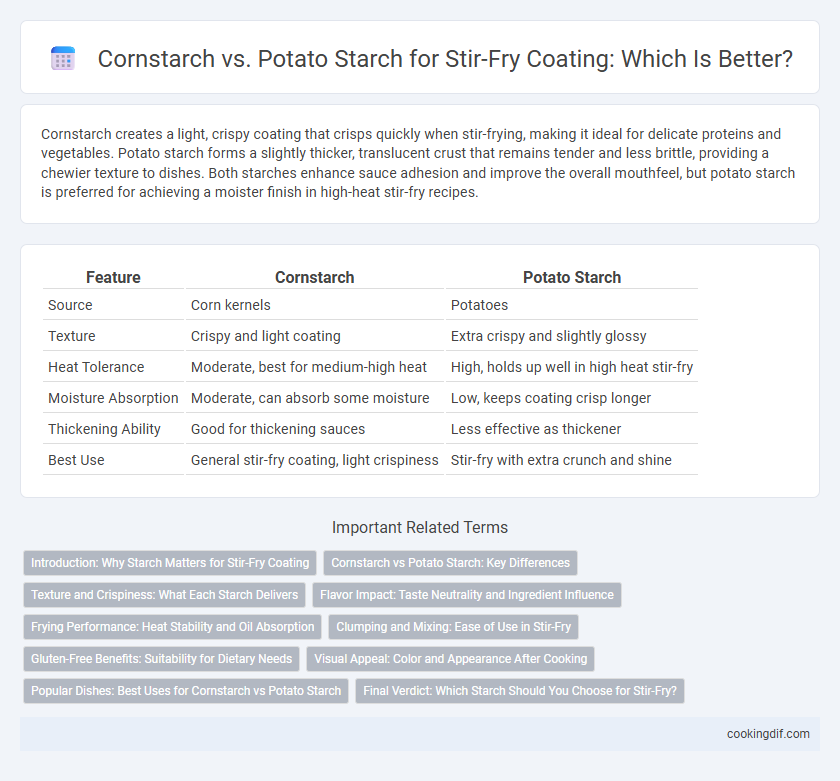Cornstarch creates a light, crispy coating that crisps quickly when stir-frying, making it ideal for delicate proteins and vegetables. Potato starch forms a slightly thicker, translucent crust that remains tender and less brittle, providing a chewier texture to dishes. Both starches enhance sauce adhesion and improve the overall mouthfeel, but potato starch is preferred for achieving a moister finish in high-heat stir-fry recipes.
Table of Comparison
| Feature | Cornstarch | Potato Starch |
|---|---|---|
| Source | Corn kernels | Potatoes |
| Texture | Crispy and light coating | Extra crispy and slightly glossy |
| Heat Tolerance | Moderate, best for medium-high heat | High, holds up well in high heat stir-fry |
| Moisture Absorption | Moderate, can absorb some moisture | Low, keeps coating crisp longer |
| Thickening Ability | Good for thickening sauces | Less effective as thickener |
| Best Use | General stir-fry coating, light crispiness | Stir-fry with extra crunch and shine |
Introduction: Why Starch Matters for Stir-Fry Coating
Choosing the right starch for stir-fry coating significantly affects texture and crispiness, with cornstarch and potato starch being the most popular options. Cornstarch creates a light, delicate crust ideal for quick frying, while potato starch offers a thicker, more resilient coating that withstands longer cooking times without sogginess. Understanding these differences ensures a perfectly crisp exterior and tender interior in stir-fried dishes.
Cornstarch vs Potato Starch: Key Differences
Cornstarch and potato starch differ significantly in texture and cooking properties for stir-fry coating, with cornstarch providing a crispier, thinner crust due to its fine granules and high amylose content. Potato starch, extracted from potatoes, delivers a lighter, fluffier coating with superior moisture retention and better heat tolerance, ideal for achieving a tender interior. Both starches excel at creating a protective barrier to lock in flavor, but choosing between cornstarch and potato starch depends on desired texture and heat resilience in stir-fry preparation.
Texture and Crispiness: What Each Starch Delivers
Cornstarch creates a thin, light, and crispy coating that crisps up quickly, making it ideal for delicate stir-fried dishes requiring a crisp texture. Potato starch delivers a thicker, more substantial crust with a slightly chewier bite, often preferred for retaining moisture and enhancing crunchiness in heartier stir-fries. Both starches excel in achieving different crispy textures, with cornstarch favoring a lighter crunch and potato starch offering durability and a more pronounced crisp.
Flavor Impact: Taste Neutrality and Ingredient Influence
Cornstarch offers a neutral taste that preserves the natural flavors of stir-fry ingredients without adding any unwanted flavors. Potato starch also maintains a mild profile but can impart a slightly earthier note, subtly enhancing the dish's overall flavor complexity. Choosing cornstarch ensures a clean, crisp coating, while potato starch may contribute a richer mouthfeel and deeper taste influence in stir-fried dishes.
Frying Performance: Heat Stability and Oil Absorption
Potato starch offers superior heat stability during high-temperature stir-frying, maintaining crispness and resisting breakdown better than cornstarch. Cornstarch tends to absorb more oil, resulting in a greasier texture, while potato starch creates a lighter, less oily coating. Choosing potato starch enhances frying performance by producing a crunchier finish with lower oil absorption.
Clumping and Mixing: Ease of Use in Stir-Fry
Cornstarch and potato starch differ significantly in their behavior when used for coating in stir-fry dishes, particularly in terms of clumping and mixing ease. Cornstarch tends to clump more easily in liquid, requiring careful, gradual incorporation and continuous stirring to achieve a smooth, even coating on proteins and vegetables. Potato starch offers better suspension and smoother mixing due to its larger granules, reducing clumping and providing a silkier texture ideal for quick, high-heat stir-fry preparations.
Gluten-Free Benefits: Suitability for Dietary Needs
Potato starch and cornstarch are both popular gluten-free options for coating in stir-fry recipes, making them suitable for individuals with gluten intolerance or celiac disease. Potato starch offers a lighter, crispier texture with excellent moisture retention, while cornstarch provides a slightly denser, glossy finish that enhances the visual appeal of stir-fried dishes. Selecting either starch ensures a safe, gluten-free alternative that meets specific dietary needs without compromising texture or flavor.
Visual Appeal: Color and Appearance After Cooking
Cornstarch creates a lighter, more translucent coating that crisps to a pale golden color, enhancing the visual appeal of stir-fried dishes with a delicate, almost glossy finish. Potato starch yields a thicker, more opaque crust that tends to brown more evenly, producing a richer golden to deep amber hue which adds a more robust, rustic appearance. Choosing between cornstarch and potato starch for stir-fry coating affects not only texture but also the final color and presentation, with cornstarch favoring a lighter, brighter look and potato starch offering a darker, more substantial visual impact.
Popular Dishes: Best Uses for Cornstarch vs Potato Starch
Cornstarch is ideal for coating in stir-fry dishes like General Tso's chicken and crispy orange chicken, providing a smooth, translucent finish and crisp texture. Potato starch excels in recipes such as Mongolian beef and tempura-style vegetables, yielding a lighter, crunchier coating that withstands high heat without hardening. Both starches enhance texture, but cornstarch is preferred for thicker sauces while potato starch delivers superior lightness and crispness in popular Asian stir-fry dishes.
Final Verdict: Which Starch Should You Choose for Stir-Fry?
Potato starch provides a lighter, crispier coating for stir-fry dishes, making it ideal for delicate proteins like shrimp or chicken, while cornstarch delivers a slightly thicker, more opaque crust that works well for beef or pork. Potato starch retains its crunch even when re-exposed to heat and moisture, enhancing texture throughout the cooking process. Choosing between cornstarch and potato starch ultimately depends on the desired crispness and transparency, with potato starch favored for its superior texture and cornstarch preferred for its availability and cost-effectiveness.
Cornstarch vs Potato starch for coating Infographic

 cookingdif.com
cookingdif.com